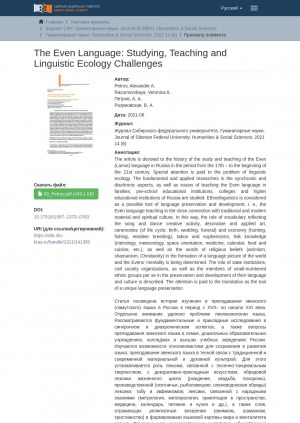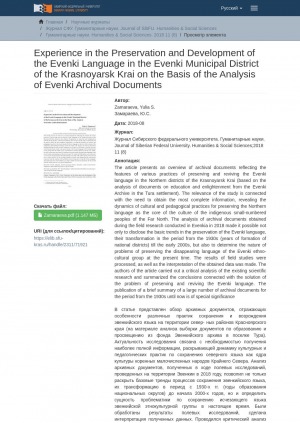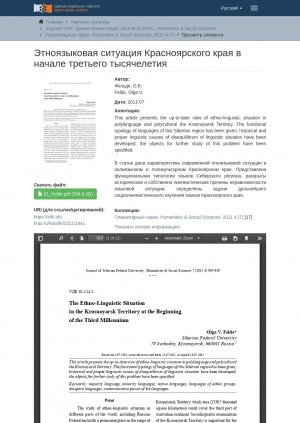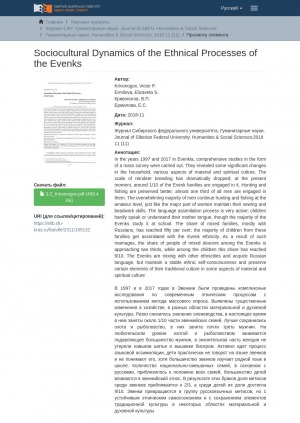Образован в 2006 г. путем объединения 4-х вузов Сибири: Красноярский государственный университет, Красноярский государственный технический университет, Красноярская государственная архитектурно-строительная академия, Государственный университет цветных металлов и золота.
Год выпуска: 2011
В статье рассматривается модель создания бизнес-инкубатора в Эвенкийском муниципальном районе на основе взаимодействия Сибирского федерального университета, администрации района и финансово-промышленных групп. Приводятся основные направления деятельности бизнес-инкубатора и его структура. Особенность бизнес-инкубатора должна быть в том, что он будет способствовать как экономическому, так и социально-культурному развитию территории, а именно реализация проекта по созданию бизнес-инкубатора должна обеспечить высокое качество жизни населения, конкурентную способность производств, сохранение культурного наследия коренных малочисленных народов
Год выпуска: 2014
Статья посвящена обзору визуально-антропологических проектов, исследующих культуру индигенных народов как в зарубежных, так и в отечественных практиках. Рассматривается развитие визуальной антропологии как отдельной области гуманитарного знания – с момента появления первых визуально-антропологических опытов до актуальных исследований, обозначаются основные линии ее развития в контексте изучения визуальных систем индигенных народов, т.е. такой этнокультурной группы, чье развитие не обозначается в законченном качестве, а продолжается в процессе взаимодействия с мультикультурным сообществом
Год выпуска: 2021
Статья посвящена истории изучения и преподавания эвенского (ламутского) языка в России в период с XVII– по начало XXI века. Отдельное внимание уделено проблеме лингвоэкологии языка. Рассматриваются фундаментальные и прикладные исследования в синхронном и диахроническом аспектах, а также вопросы преподавания эвенского языка в семье, дошкольных образовательных учреждениях, колледжах и высших учебных заведениях России. Изучаются возможности этнолингвистики для сохранения и развития языка: преподавание эвенского языка в тесной связи с традиционной и современной материальной и духовной культурой. Для этого устанавливается роль лексики, связанной с песенно-танцевальным творчеством, с декоративно-прикладным искусством, обрядовой лексики жизненного цикла (рождение, свадьба, похороны), производственной (охотничьи, рыболовецкие, оленеводческие обряды) лексики; табу и эвфемизмов; лексики, связанной с народными знаниями (метрология, метеорология, ориентация в пространстве, медицина, календарь, питание и кухня и др.), а также слов, отражающих религиозные воззрения (анимизм, шаманизм, христианство) в формировании языковой картины мира и менталитета эвенов. Отмечена роль государственных институтов, общественных организаций, а также самих представителей малочисленного этноса в сохранении и развитии своих языка и культуры. Обращено внимание на перевод как инструмент сохранения уникального языка
Год выпуска: 2016
Статья посвящена анализу сюжетного материала и структуры долганских сказок. Авторы считают, что северный фольклор является не только частью самобытного устного творчества коренных народов, но и важной составляющей в формировании этнической идентичности. В связи с этим изучение сюжетов позволит понять особенности северной культуры долганского народа, выявить структуру и устройство сконструированного в сказках мира
Год выпуска: 2012
В статье представлены цели, задачи и результаты работ по проекту "Разработка механизмов вовлечения коренных народов Севера Красноярского края в инновационные социально- экономические процессы с участием федерального образовательного учреждения" на 2010 год. Приведены основные методы исследования и результаты анализа технического состояния зданий в северных поселках Ессей и Носок. Проведены и представлены анализ традиционного кочевого жилья и анализ существующего на данный момент жилья в самом поселке. Подробно описаны разрушения и дефекты существующих строений, и приведен анализ текущего состояния строительства новых объектов в этих поселках
Год выпуска: 2018
В статье представлен обзор архивных документов, отражающих особенности различных практик сохранения и возрождения эвенкийского языка на территории север- ных районов Красноярского края (на материале анализа выборки документов по образованию и просвещению из фонда Эвенкийского архива в поселке Тура). Актуальность исследования связана с необходимостью получения наиболее полной информации, раскрывающей динамику культурных и педагогических практик по сохранению северного языка как ядра культуры коренных малочисленных народов Крайнего Севера. Анализ архивных документов, полученных в ходе полевых исследований, проведенных на территории Эвенкии в 2018 году, позволил не только раскрыть базовые тренды процессов сохранения эвенкийского языка, их трансформацию в период с 1930-х гг. (годы образования национальных округов) до начала 2000-х годов, но и определить сущность проблематики по сохранению исчезающего языка эвенкийской этнокультурной группы в настоящее время. Были обработаны результаты полевых исследований, сделана интерпретация полученных данных. Проводился критический анализ существующих научных исследований, обобщены выводы исследователей, связанных с решением проблемы сохранения и возрождения эвенкийского языка. Особую значимость имеет публикация краткого содержания большого количества архивных документов за период с 1930 гг. по настоящее время
Год выпуска: 2011
В статье дана характеристика современной этноязыковой ситуации в полиязычном и поликультурном Красноярском крае. Представлена функциональная типология языков Сибирского региона, раскрыты исторические и собственно лингвистические причины неравновесности языковой ситуации, определены задачи дальнейшего социолингвистического изучения языков Красноярского края
Год выпуска: 2016
В статье представлен обзор основных этапов развития литературного творчества коренных народов Севера, Сибири и Дальнего Востока. Рассмотрены ключевые особенности литературы коренных народов. Выявлена специфика прозы и поэтического творчества. Обозначено несколько различных научных точек зрения на сущность и характер творчества коренных народов как на этнокультурное явление. Сделаны выводы об этноформирующих качествах литературного творчества коренных народов, которое можно рассматривать как один из эффективных способов конструирования этнокультурной и национальной идентичности в современном мире
Год выпуска: 2018
В статье рассматривается один из аспектов культурогенеза народов Севера Красноярского края. Описывается взаимное влияние коренных народов Севера Средней Сибири и русского населения в области материальной и духовной культуры. Христианизация аборигенного населения соседствует с проникновением шаманизма в верования русских. Долгане и кеты заимствуют у русских новые типы транспорта и жилищ. Автохтонное население передает русскому суперэтносу свои способы хозяйствования, одежду, заимствуя, в свою очередь, предметы промышленного производства и продукты питания. Распространяется табакокурение и алкоголь. Чересполосное проживание аборигенных народов приводит к заимствованию у соседей погребальных обрядов, бытовых предметов и украшений, способов охоты и рыболовства, а также оленеводства
Год выпуска: 2018
В 1997 и в 2017 годах в Эвенкии были проведены комплексные исследования по современным этническим процессам с использованием метода массового опроса. Выявлены существенные изменения в хозяйстве, в разных областях материальной и духовной культуры. Резко снизилось значение оленеводства, в настоящее время в нем заняты около 1/10 части эвенкийских семей. Лучше сохранились охота и рыболовство, в них занята почти треть мужчин. На любительском уровне охотой и рыболовством занимается подавляющее большинство мужчин, а значительная часть женщин не утеряли навыков шитья и вышивки бисером. Активно идет процесс языковой ассимиляции, дети практически не говорят на языке эвенков и не понимают его, хотя большинство эвенков изучает родной язык в школе. Количество национально-смешанных семей, в основном с русскими, приблизилось к половине всех семей, большинство детей вливаются в эвенкийский этнос. В результате этих браков доля метисов среди эвенков приближается к 2/3, а среди детей их доля достигла 9/10. Эвенки превращаются в группу русскоязычных метисов, но с устойчивым этническим самосознанием и с сохранением элементов традиционной культуры в некоторых областях материальной и духовной культуры









